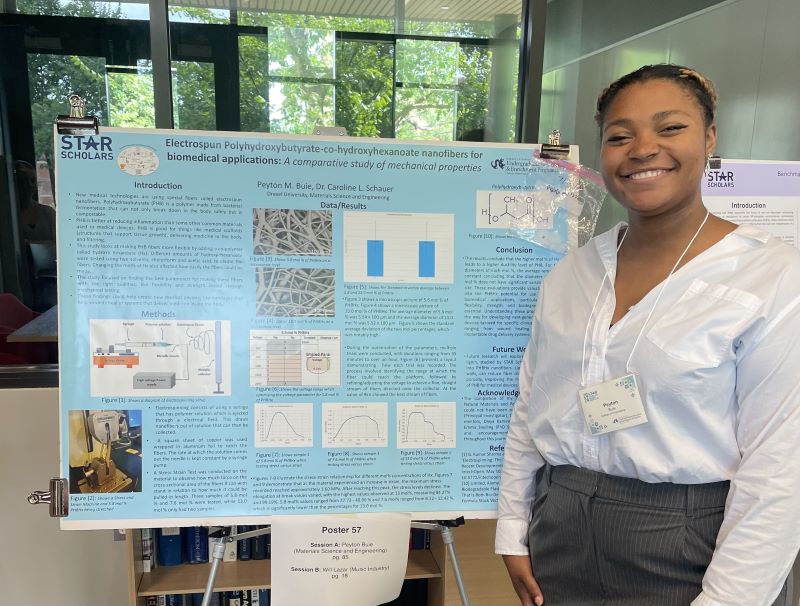
Peyton Buie with her research poster at the STAR Showcase.
Drexel Materials undergraduate student Peyton Buie has a two-part answer for why she chose materials as her major. “One is to explore a field that can explain the characteristics of materials at a microscopic level, allowing one to develop new materials or improve existing ones,” she explains. “Two, when using your creativity, the sky’s the limit. It is a field that allows for innovation and transformation through advancing technology covering each discipline of engineering.”
For Buie, the Drexel Students Tackling Advanced Research (STAR) Scholars Program was a perfect opportunity to get an early start building research skills and kick-start her exploration of the materials field’s wide-ranging applications. Rising sophomores participate in STAR during the summer after their first year, conducting research in a faculty member’s lab while receiving a stipend and free on-campus housing for the duration of the ten-week immersive program. The experience culminates in the STAR Showcase where participants present posters of their work.

Buie electrospinning a PHBHx sample.
Buie’s STAR experience took place in the Natural Materials and Polymer Processing Lab, led by Margaret C. Burns Chair of Engineering Caroline Schauer. Under the guidance of Schauer and her co-advisors, PhD students Divya Kamireddi and Emma Snelling, Buie created and tested variations of the biopolymer poly[(R)-3-hydroxybutyrate-co-(R)-3-hydroxyhexanoate] (PHBHx), which is a co polymer of Polyhydroxyhexabutyrate (PHB) and Hydroxy Hexanoate (Hx).
PHB is a bacterially derived biodegradable polyester that has shown potential in biomedical applications such as tissue engineering scaffolds and transdermal patches for drug delivery. Unfortunately, it is very brittle by nature, which is a major obstacle for these applications. Combining PHB with HX disrupts its rigid crystalline plane, allowing it to become more flexible.

One of Buie's PHBHx samples.
Since her project involved electrospinning PHBHx with different mole percentages of Hx, it was essential that Buie become skilled in creating various PHBHx solutions, and in knowing how to optimize their electrospinning parameters. She also learned how to test her samples for strain and stress to determine their elasticity.
Beyond the lab skills she acquired, Buie gained insights into the true nature of research. “I learned that research is not as exciting where things are happening at a fast rate but as a slow progression,” she says. “I learned patience and persistence. Sitting in a designated spot watching a machine do its magic for hours at a time over a course of weeks is not the most enthralling experience. But that did not discourage me from my work.”
Buie also sees tremendous value in the sense of community provided by the STAR program. “Building bonds with my peers and mentors encouraged me to have a positive outlook on research. One thing that I can say for sure is that taking on research can be overwhelming, but if taken in small increments it can be digestible, and it all starts with not being afraid to ask questions.”
Prospective students can apply to STAR during the admissions process and current first-year and transfer students can apply through the mid-year application process, which opens during fall term and closes in winter term. Additionally, Undergraduate Research & Enrichment Programs (UREP) is now offering Launchpad to STAR, which includes a variety of workshops in fall term to help students understand what research is and how to get involved.